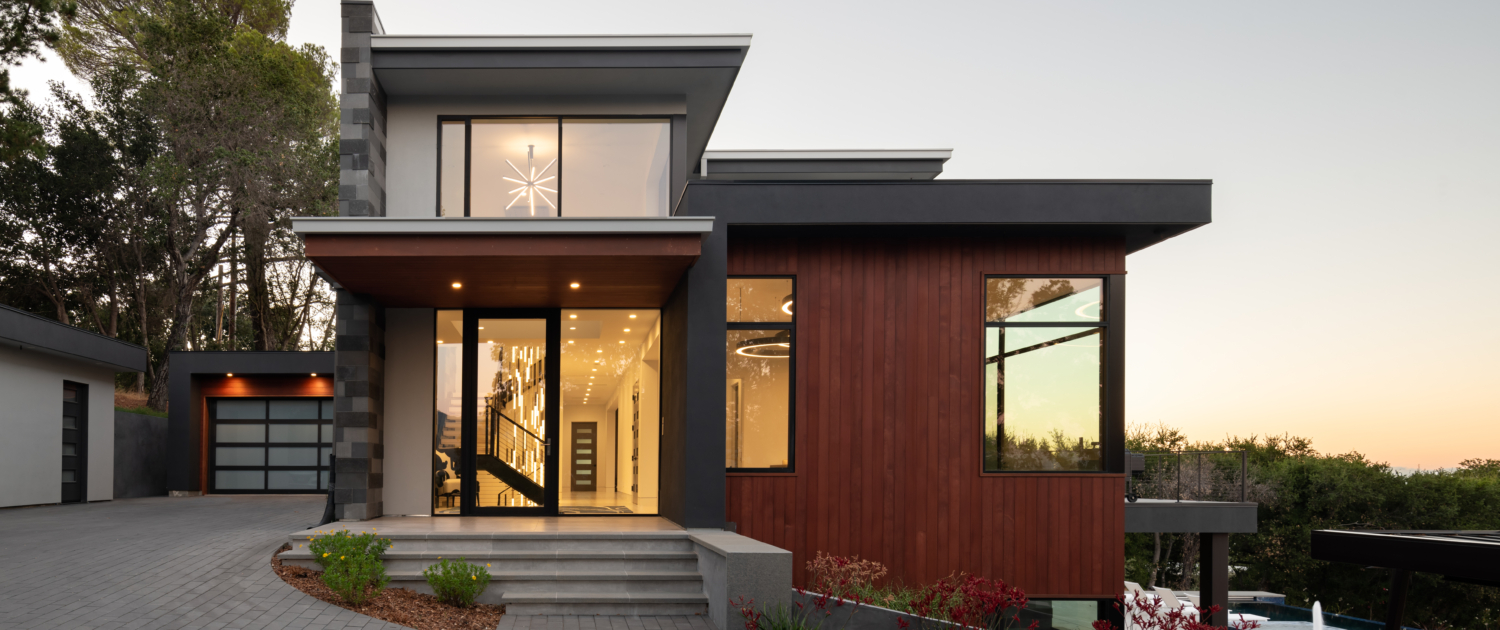Weatherize Your Home for Winter: Essential Tips

While winters in Silicon Valley and the mid-Peninsula don’t typically bring snow, excessive rain, or ice, this year, the scenario is expected to take an intriguing turn. The specter of unpredictable winter weather looms large, as a significant 95% likelihood of El Niño conditions through March adds a new layer of uncertainty to the season. In preparation for potential weather fluctuations, there are still some essential home maintenance items that will keep your home performing efficiently during the cooler months ahead.
Enter HarrellCARE Program Manager Marshall Parker, our resident expert in ensuring your home is winter-ready. First and foremost, Marshall advises focusing on the exterior.
“With lots of predicted rain coming this year, keeping moisture out of your home is essential,” Marshall emphasizes. “Also, since the days are shorter, and it gets dark earlier in the evening, making sure the outside of your home is well-lit is an important safety factor.”
Here are ten key areas to “button down” before winter.
1. Gutters
Clearing gutters of leaves and debris is essential, especially with the frequent occurrence of wildfires. Airborne embers from a fire can travel for miles, and dry residue in gutters can quickly ignite.
And, if we get significant rain, blocked gutters can result in composted leaves and debris clogging your gutters and downspouts. With nowhere to go, water could overflow and potentially back up under your roofing material, and worst case, into your home. Continual moisture leads to rust, which, over time, causes gutters to fail.
2. Roof
Debris can accumulate on your roof and, if left alone, can degrade the shingles. Removing leaves, sticks, and other unwanted materials and clearing out roof valleys extends the life of your roof, keeps water out of your home, and prevents airborne embers from igniting dry materials.
3. Windows, doors, trim, and casings
Inspect all windows and doors along with trim (the material that surrounds exterior doors and windows) and casings (the material that surrounds interior doors and windows). Look for dried-out caulking, cracks, or other damage that could be an entry point for moisture. Clean, prime, and paint affected areas while the weather is still warm.
Weatherstripping degrades over time, causing gaps that allow warm air to escape. If, while inside, you notice light around the edges of your doors and windows, that indicates applying new weatherstripping and/or door sweeps should be high on your list.
Marshall cautions homeowners with pet doors to close them when heading out on holiday. Otherwise, you may come home to a family of raccoons or skunks cuddled up on your couch.
4. Trees & Plants
Visually inspect large trees. Look for large branches that could break off in a windstorm and have them removed. Mushrooms growing at the base of trees could be an indicator of poor tree health. If you have any concerns, it’s wise to bring in a licensed arborist.
Have frost blankets on hand if you have plants that are sensitive to cold. Cover them if nighttime temperatures drop into the 30s. Adding a layer of mulch to planting beds protects roots and bulbs.
5. Fencing, Pergolas, Trellises
Walk the perimeter of your yard and push up against each fence post. If any of them feel loose, now’s the time to secure them properly. Check for unattached, rotting, or damaged fence boards. This same process applies to arbors, pergolas, and trellises. Ensure the structures are intact and solid.
6. Lighting
As the days become shorter, odds are you’ll be leaving and returning home more often in the dark. Check to be sure all outdoor lights on the exterior of your home and in your yard are functional. Replace bulbs as needed and, for lights on a timer, ensure they will switch on earlier if they aren’t photosensitive. Be sure to check the address lights on your home as well. Lighted street numbers help first responders (and delivery drivers!) locate your home.
7. Outdoor Furnishings
To prolong their life, cover outdoor furniture or store cushions indoors. It’s also a good idea to protect your BBQ if you don’t use it during the winter months.
8. French Drains & Ejectors Pumps
For homes located on sloped or hilly terrain, test your underground French drains to ensure they are clear of any obstacles, and that water flows freely away from your home. If you have an ejector pump, now is the time to make sure it’s operational or have it serviced.
9. Crawlspace Screens
For those homes with crawlspaces, check that all screens are intact. It’s also a good idea to clear away leaves, dirt, or mulch that may be blocking these vents.
Marshall points out that screens keep unwanted critters from invading the crawlspace while also allowing necessary airflow. He also suggests removing dirt or debris build-up against the house as it increases the chances for termites and water intrusion.
10. Hose Bibs
Although it doesn’t get East Coast cold in the Bay Area, it’s still not a bad idea to wrap exposed hose bibs and other pipes. Marshall also recommends installing anti-siphon valves on hose bibs that don’t have them.
Now, let’s talk about the eight items to address inside your home.
1. Smoke and Carbon Monoxide Detectors
Replace batteries and make sure that the units are up-to-date and haven’t expired. Most newer detectors have ten-year batteries or are hardwired into the home’s electrical system.
Marshall advises taking a few minutes to confirm they function correctly.
“Detectors are an essential safety precaution. Making sure the units all work properly can save lives.”
2. Furnace
Now’s the time to change out the air filter in your furnace. The dust and dirt that’s accumulated keeps your unit from operating at peak efficiency.
With the poor air quality we’ve encountered lately, many homeowners are interested in adding high-particulate filters to their HVAC systems. These high-efficiency filters have the potential to become a chokepoint for your entire system, depending upon the age and model. If these filters are something you’re considering, it’s best to have a licensed professional check your HVAC system, including ducting, to see if this option is suitable for your home.
Marshall also recommends turning on your furnace to ensure it works. If it fails during a cold snap, you may have a tough time getting it repaired quickly. If you feel comfortable doing so, open the furnace cover and vacuum out any dust, or have it professionally serviced.
3. Water Heater
For homes with standard water tanks, it’s suggested they be flushed out at least once a year. Over time, silt and calcium can build up inside the unit, reducing the unit’s efficiency and volume of water available to heat.
Check on the status of your unit’s anode rod. If it’s looking worn, it may be time for a new one.
If it’s not already, wrap your tank with a thermal insulating blanket to maximize efficiency. And, if you leave home on vacation, Marshall recommends turning down your water heater but not turning it off.
Every so often, tankless water heaters need servicing, especially if you have hard water. This should be done by a plumbing professional.
4. Fireplace
For the few homes that still use a wood-burning fireplace as a primary heat source, now’s the time to clean out the chimney or stove pipe to remove any built-up creosote.
For those with gas fireplaces, make sure it functions correctly and if not, call in a service professional. Ensure the pilot light is lit and remove dust and debris from the interior. This service is often best performed by a professional.
5. Pilot lights
Some homes have older wall furnaces or gas fireplaces that have pilot lights. Many homeowners will extinguish these during summer, and now is the time to enlist the help of someone who understands how to reignite them.
PG&E offers this service; you can schedule an appointment here.
6. Ceiling Fans
In the winter, if you use them, reverse the direction and your ceiling fan will blow warm air downward to help heat your home.
7. Thermostats
Programmable and smart thermostats “dial-in” your home’s energy efficiency. For winter, Energy.gov recommends setting your thermostat to 68 degrees Fahrenheit when you’re at home and awake. Lowering your thermostat 10-15 degrees during the eight hours your household is asleep can reduce your heating bill by 5-15%.
If you leave home for an extended period, don’t turn off your thermostat. Marshall suggests setting it to a low temperature to ensure water pipes or fire sprinklers don’t get too cold, freeze, and break.
“I know it sounds silly in our mild, temperate climate, but it has happened,” says Marshall. “You don’t want to come home from vacation to find your home flooded.”
8. Insulation
If you live in an older home, insulation is one of the best investments you can make to your home’s efficiency and comfort. It significantly decreases heat loss in winter and keeps your home cool in summer.
“Dual-pane windows are another great energy-saver,” Marshall confirms. “As an added bonus, they also reduce sound transfer when the windows are closed.”
Power Outage Advice
If you have a backup generator for use during power outages, be sure it is placed away from your house or garage, runs on gas, and is connected to an extension cord rated for outdoor use. A licensed electrician should install larger generators, which are hooked up directly to the main electrical panel with a transfer switch.
Be sure to have batteries, flashlights, candles, extra blankets, an emergency kit, and shelf-stable food on hand in the event of a prolonged power outage.
As a single source from design conception through construction, Harrell Design + Build provides clients with unmatched service, convenience, and quality. Our Design + Build process can help you embrace your aesthetic, make the most of your resources, and create quality spaces that fit the unique way that you live.
Connect with one of our award-winning designers or attend one of our workshops to learn more about the Harrell Design + Build Design + Build experience.
Woman Founded and 100% Employee-Owned, Harrell Design + Build has created distinctive homes in Silicon Valley and on the mid-Peninsula since 1985. Our Design + Build Team is here to help you reimagine (and maintain) your home inside and out.





